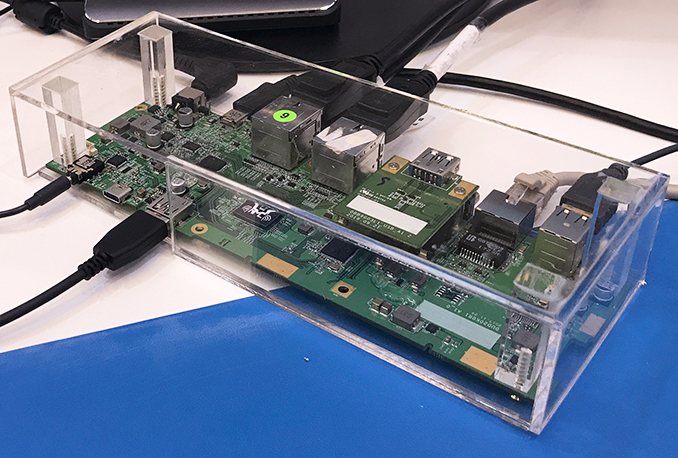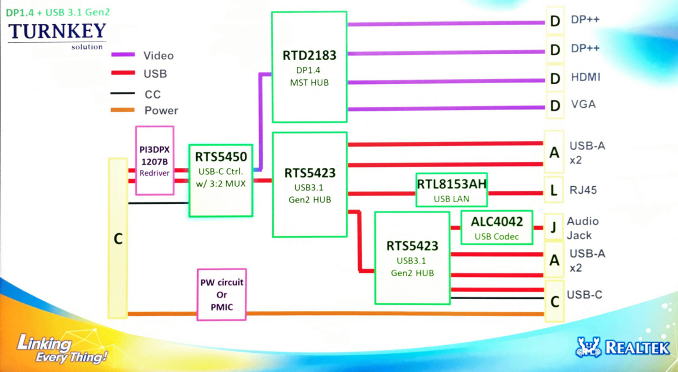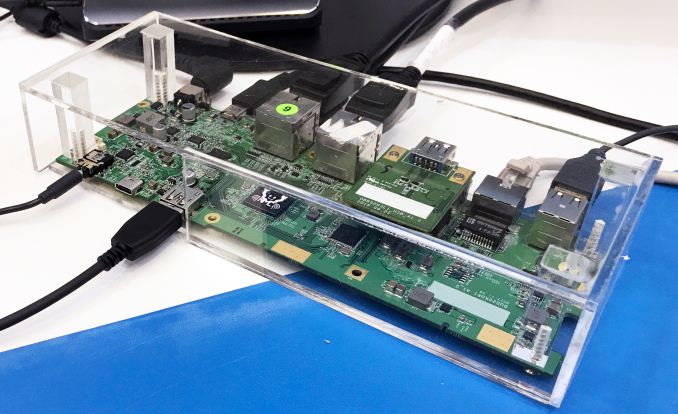Realtek Demonstrates a USB 3.1 G2 Type-C Dock Platform: An All-in-One Solution
by Anton Shilov on June 18, 2018 2:00 PM EST- Posted in
- Peripherals
- Trade Shows
- Realtek
- USB-C
- USB-C Hub
- Computex 2018

Realtek demonstrated a prototype of a USB 3.1 Gen 2 docking station that relies entirely on its own chips and features regular connectors, including USB Type-A, DisplayPort, HDMI, D-Sub, GbE, and audio.
USB Type-C is gaining popularity rather rapidly among notebook makers and there are a number of non-Apple laptops that feature only these connectors. Meanwhile, such laptops need docking stations to gain compatibility with regular USB Type-A, Gigabit Ethernet, display outputs and so on. Such devices are available, but are not always cheap because makers of hubs have to develop these products themselves and use chips from various suppliers. By contrast, Realtek’s turnkey USB 3.1 Gen 2 hub is based on chips that come exclusively from the company and the whole design is production ready, meaning no R&D investments from actual manufacturers.
Realtek’s turnkey USB 3.1 Gen 2 (10 Gb/s) hub relies on the firm’s RTS5423, RTS5450, RTD2183, RTL8153AH, ALC4042, and the PI3DPX 1207B chips. The hub features four USB Type-A connectors, a USB Type-C header, two DisplayPort 1.4 outputs, an HDMI, a D-Sub, an 3.5-mm TRRS audio jack, and a GbE port.
Realtek naturally does not indicate pricing of actual solutions based on its reference design because they depend on materials used and actual configuration of connectors. Today sophisticated USB-C docking solutions start at €109/$127, so hopefully Realtek’s turnkey dock will enable makers to bring the price of such products a bit down.
| Want to keep up to date with all of our Computex 2018 Coverage? | ||||||
 Laptops |
 Hardware |
 Chips |
||||
| Follow AnandTech's breaking news here! | ||||||












23 Comments
View All Comments
psychobriggsy - Tuesday, June 19, 2018 - link
It's a real shame that they cannot amalgamate a lot of that functionality into a single chip, preferably without an internal USB hub chain unlike this design.Input: USB 3.1 Rev1 or Rev2 (5 or 10 Gbps)
Outputs: GigE, Audio, USB 3.1 x4 (Type A or Type C), Video from Alt-Mode
Also how does the Audio controller on that hub integrate with the HDMI output? Does it stream the audio digitally back to the host computer to put on the video output over USB Alt Mode?
serendip - Tuesday, June 19, 2018 - link
How about using it with phones? Most have USB-C now and hopefully SoCs include the right outputs for data and video. WiDi or Miracast can't handle high resolutions and latency is a big issue.fteoath64 - Wednesday, June 20, 2018 - link
Unfortunately, the USB-C connector in most phones and tablets support ony USB2 connection speeds instead of 3.0 or 3.1. I think it is a power issue in the implementation. But it is a shame that most cannot copy large files from PC at a decent speed. We had to resort to USB3 stick to copy video and large presentation across devices without a high-speed wireless link.Of course, we users want a way for large phones and tablets to be connected via USB-C and play hi-def video with sufficient voice controls to allow personal mobility around a house or conf room. But a myriad of devices are required making it very inconvenient. ChromeCast/Miracast tends to used but at best a mideocre solution and at times very unreliable. Why ise wireless if a cable can also charge the device and provide high-quality and low latency ?. We are not really given such choices by the manufacturers ....